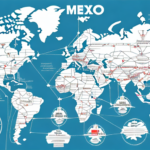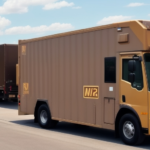Introduction to UPS and FedEx Shipping Services
UPS and FedEx are two of the largest logistics companies globally, offering a comprehensive range of shipping services to businesses and individuals alike. From overnight delivery to ground shipping, both carriers provide options tailored to various shipping needs. Additionally, they offer robust support tools, including package tracking and insurance, enhancing the overall shipping experience for customers.
International Shipping: A key differentiator between UPS and FedEx is their approach to international shipping. According to their 2023 annual reports, UPS boasts a more extensive global network, facilitating smoother navigation through international customs and regulatory landscapes. In contrast, FedEx is renowned for its faster delivery times and more precise tracking information. This distinction is crucial for businesses with specific shipping requirements, potentially making one carrier more suitable than the other based on their unique needs.
Shipping Rates for Small Boxes: Why It Matters
The cost associated with shipping small boxes is a vital consideration for businesses, particularly small enterprises. Shipping expenses can substantially impact a company's profit margins, making the selection of a cost-effective carrier essential for sustained financial health. Identifying the most economical shipping option often translates to significant cost savings over time.
Delivery Time vs. Cost: Beyond mere pricing, delivery time plays a pivotal role in selecting a shipping carrier. Some carriers may offer lower rates but at the expense of longer delivery times, which can be detrimental for businesses requiring swift delivery to their customers. Balancing affordable rates with timely delivery is crucial to maintain customer satisfaction and operational efficiency.
Customer Service: The quality of customer service provided by the carrier also influences the overall shipping experience. Exceptional customer service can aid businesses in resolving issues like lost or damaged packages promptly, saving both time and resources. Reliable customer support ensures that businesses can manage shipping challenges without significant disruptions.
How to Estimate Shipping Costs for Small Boxes
Estimating shipping costs for small boxes involves several factors, including package weight and dimensions, shipping destination, and delivery speed. Both UPS and FedEx offer user-friendly calculators on their websites that allow customers to estimate shipping costs accurately. These calculators consider package weight, destination, and shipping speed to determine the total cost.
Choosing the Right Shipping Service: The type of shipping service selected can significantly impact the cost. For urgent deliveries, more expensive options like overnight or express shipping may be necessary. Conversely, if delivery speed is flexible, opting for slower, less costly shipping methods can lead to substantial savings.
Packaging Efficiency: Proper packaging is essential to avoid additional fees or damages during transit. Utilizing sturdy packaging materials and filling empty spaces with packing materials, such as bubble wrap or packing peanuts, helps prevent the contents from shifting and reduces the risk of damage.
Understanding UPS and FedEx Shipping Zones
Both UPS and FedEx divide countries into shipping zones, which play a crucial role in determining shipping costs. Shipping within the same zone is generally less expensive compared to shipping between different zones. Each zone can encompass multiple states or regions, so it's advisable to consult the carrier's website to understand the zoning structure accurately.
It's important to note that the number and boundaries of zones can vary between UPS and FedEx. This variation means that a package's shipping zone may differ depending on the carrier used. Additionally, both carriers offer expedited shipping options that may be less affected by zone-related pricing.
For international shipments, both UPS and FedEx utilize a similar zone system based on countries and regions rather than states. Checking the carrier's website for specific information on international shipping zones and rates is essential before sending packages overseas.
The Role of Package Weight and Dimensions in Shipping Rates
Package weight and dimensions are critical factors in determining shipping rates. Generally, heavier and larger packages incur higher shipping costs. For example, a lightweight yet compact package may be less expensive to ship compared to a heavier, larger one. Both UPS and FedEx use a formula that accounts for both weight and size to calculate the shipping rate accurately.
Impact of Destination: Shipping rates also vary based on the distance a package must travel. For instance, shipping a package from New York to California is typically more expensive than shipping the same package from New York to New Jersey.
Shipping Service Type: The type of shipping service selected, such as express or standard shipping, further influences the cost. Express or expedited shipping options are generally more costly than standard shipping, so businesses must consider their budget and the urgency of shipments when making decisions.
Comparing UPS and FedEx Ground Shipping Rates for Small Boxes
Ground Shipping: Ground shipping is often the most economical option for businesses that can accommodate longer delivery times. Research indicates that UPS generally offers slightly cheaper rates than FedEx, especially for longer distances. UPS' Ground Commercial Plus and Commercial Base program discounts provide additional savings opportunities for businesses.
However, it's important to recognize that FedEx may offer more competitive rates for specific regions or shipping routes. Businesses should compare rates for each individual shipment to ensure they are securing the best deal.
Reliability and Speed: Beyond cost, the reliability and speed of ground shipping services are vital factors. Both UPS and FedEx have strong track records for timely deliveries, with UPS often perceived to have a slight advantage in overall reliability.
Comparing UPS and FedEx Express Shipping Rates for Small Boxes
Express Shipping: Express shipping, including overnight or next-day delivery, is the fastest and most expensive shipping option available. FedEx typically offers the most competitive rates for express shipping, particularly over shorter distances. However, shipping costs with either carrier can fluctuate based on package weight and dimensions.
Both UPS and FedEx provide additional services that can influence overall shipping costs. Services like signature confirmation or package insurance will increase the shipping cost. Additionally, high-volume shippers can benefit from discounts offered by both carriers, making frequent small box shipments more economical.
When comparing UPS and FedEx express shipping rates, delivery guarantees are a significant consideration. UPS offers a money-back guarantee if they fail to meet their delivery commitment, while FedEx provides a refund or credit toward future shipping costs if they miss their delivery commitment by even one minute.
How to Save Money on UPS and FedEx Small Box Shipping Rates
Businesses can implement several strategies to reduce shipping costs for small boxes with both UPS and FedEx:
- Negotiated Carrier Discounts: Leveraging negotiated discounts such as UPS' Commercial Plus or FedEx's Commercial Base pricing can lead to significant savings.
- Rate Comparison: Regularly comparing rates between UPS and FedEx ensures that businesses are utilizing the most cost-effective option for each shipment.
- Shipping Calculators: Utilizing shipping calculators provided by both carriers can help determine the most economical shipping method based on package size, weight, and destination.
- Flat-Rate Shipping Boxes: Using flat-rate boxes can be a cost-effective alternative, as they charge a set price regardless of weight or destination. However, it's important to compare these rates with standard shipping options to ensure maximum savings.
Tips for Choosing Between UPS and FedEx for Small Box Shipping
Choosing the right carrier for small box shipping involves evaluating several key factors:
- Shipping Costs: Compare the overall shipping costs offered by UPS and FedEx to determine which aligns best with your budget.
- Delivery Speed: Assess the importance of delivery speed for your business and customers, opting for the carrier that best meets your time requirements.
- Package Tracking: Evaluate the tracking capabilities of each carrier to ensure you can monitor shipments effectively.
- Customer Service: Consider the quality and availability of customer service, as reliable support can be crucial in resolving shipping issues promptly.
- International Shipping Needs: For businesses with significant international shipping, choose a carrier with a robust global network and expertise in customs regulations.
- Domestic Shipping Strength: If primarily shipping within the United States, select a carrier with a strong domestic network and efficient logistics.
Common Mistakes to Avoid When Comparing UPS and FedEx Shipping Rates
When comparing shipping rates between UPS and FedEx, it's essential to avoid the following common mistakes:
- Ignoring Shipping Zones: Failing to consider shipping zones can lead to inaccurate cost comparisons, as shipping between distant zones will naturally be more expensive.
- Inaccurate Package Measurements: Ensuring that package weight and dimensions are precise is crucial, as inaccuracies can result in unexpected shipping fees.
- Overlooking Additional Fees: Be aware of additional charges for services like insurance or signature confirmation, which can significantly affect the total shipping cost.
- Neglecting Volume Discounts: Not taking advantage of available volume discounts can result in higher shipping costs, especially for businesses that ship frequently.
Real-World Examples of Cost Savings with UPS or FedEx Small Box Shipping
Real-world savings with UPS and FedEx small box shipping rates vary based on factors such as package weight and destination:
- UPS Commercial Pricing: Businesses qualifying for UPS' commercial pricing schemes can save up to 18% on published rates, significantly reducing shipping expenses.
- FedEx Volume Discounts: FedEx offers discount rates of up to 35% off published rates for specific volume discounts, benefiting businesses with high shipping volumes.
Implementing these discount programs can lead to substantial cost savings, enhancing a company's profitability and competitive edge.
Additional Considerations When Choosing a Carrier for Small Box Shipping
Beyond cost and speed, several other factors should influence the choice of carrier for small box shipping:
- Delivery Speed: The required delivery timeframe can dictate the choice of carrier and shipping service.
- Package Tracking Options: Comprehensive tracking enhances visibility and security of shipments.
- Customer Service: Reliable and accessible customer service is essential for resolving any shipping issues promptly.
- Reliability: Consistent and dependable delivery performance ensures customer satisfaction and repeat business.
- Impact of External Factors: Consider external factors such as potential disruptions from events like the COVID-19 pandemic, which can affect delivery speeds and service availability.
Conclusion: Which Carrier is the Best Fit for Your Business Needs?
In conclusion, both UPS and FedEx offer competitive shipping rates for small boxes, but the optimal choice depends on your business's specific needs. Factors such as shipping volume, required delivery speed, international shipping needs, and budget constraints play pivotal roles in determining the most suitable carrier. By carefully evaluating and comparing the prices, services, and features offered by each carrier, businesses can make informed decisions that best align with their operational requirements and financial goals.




















